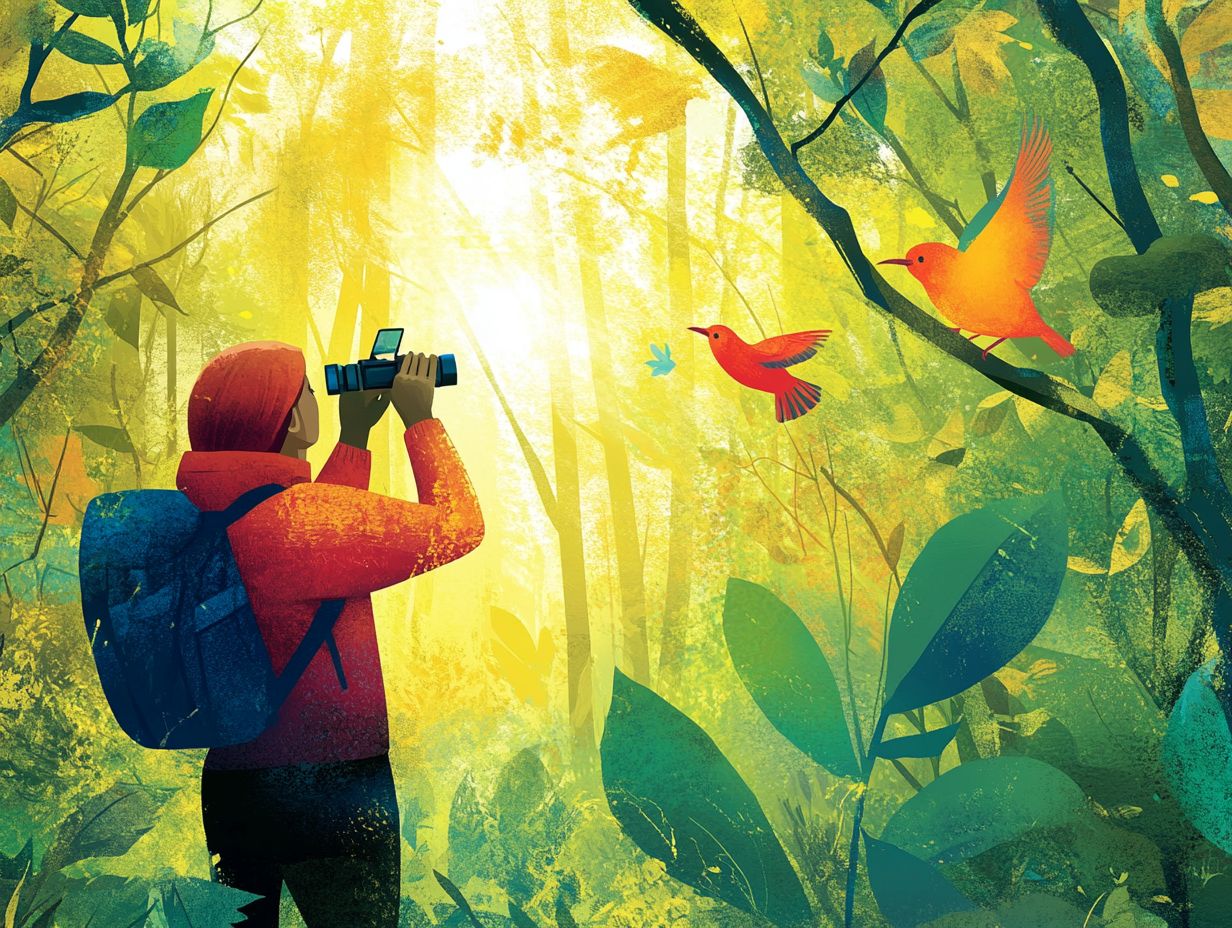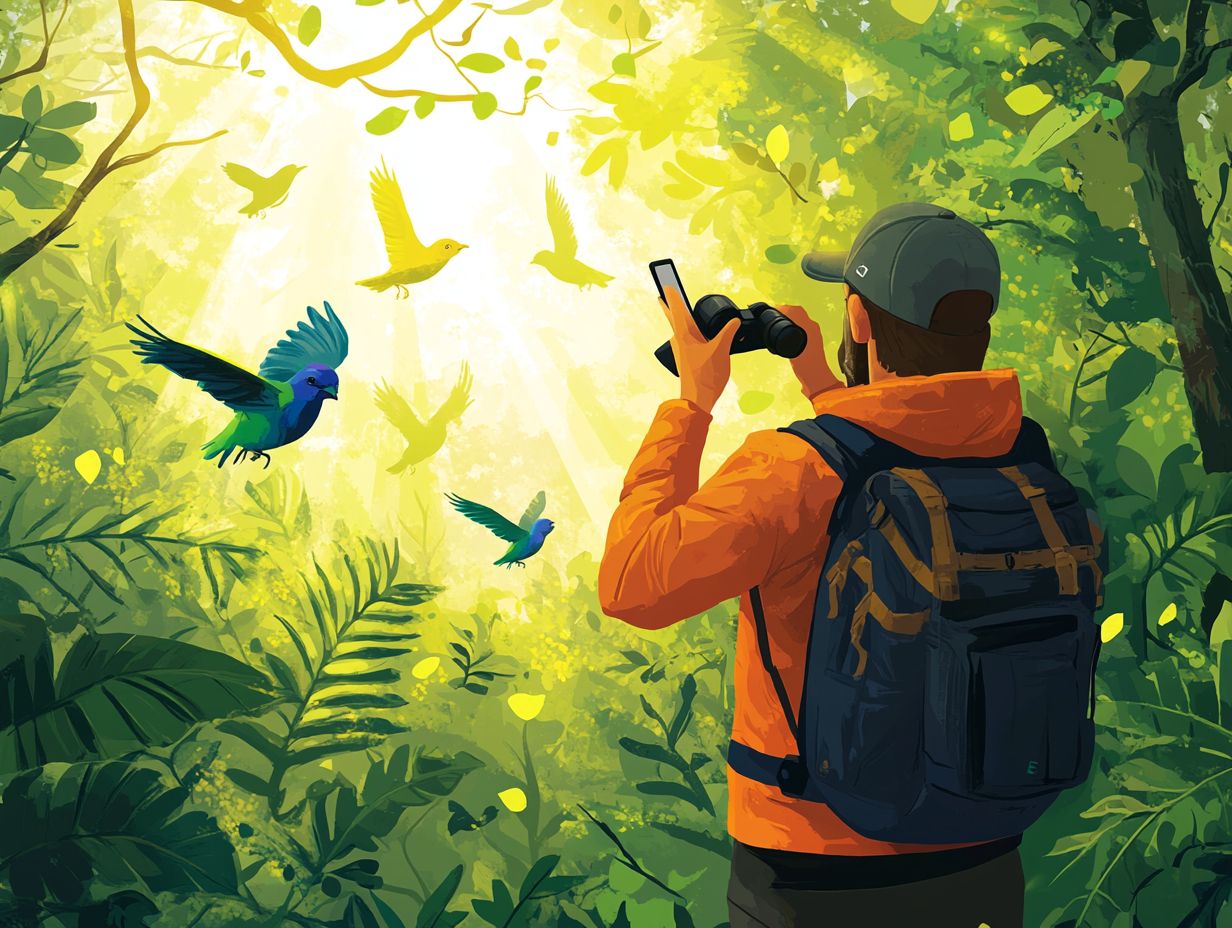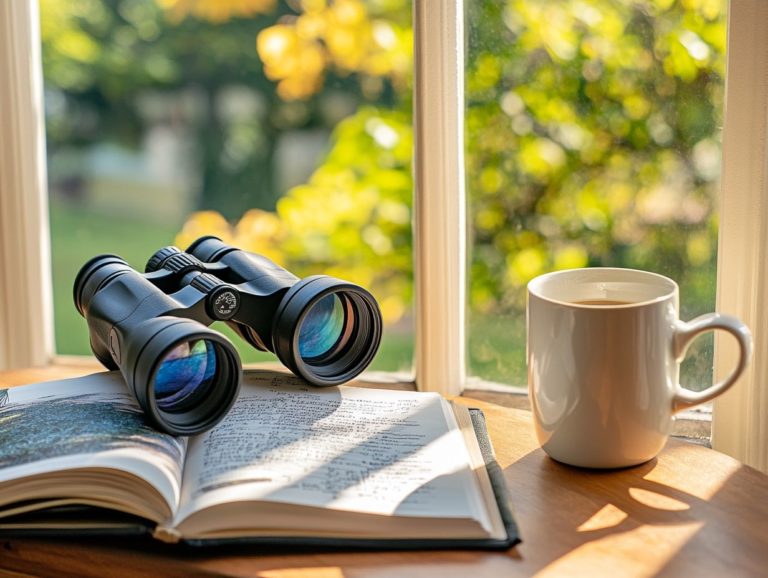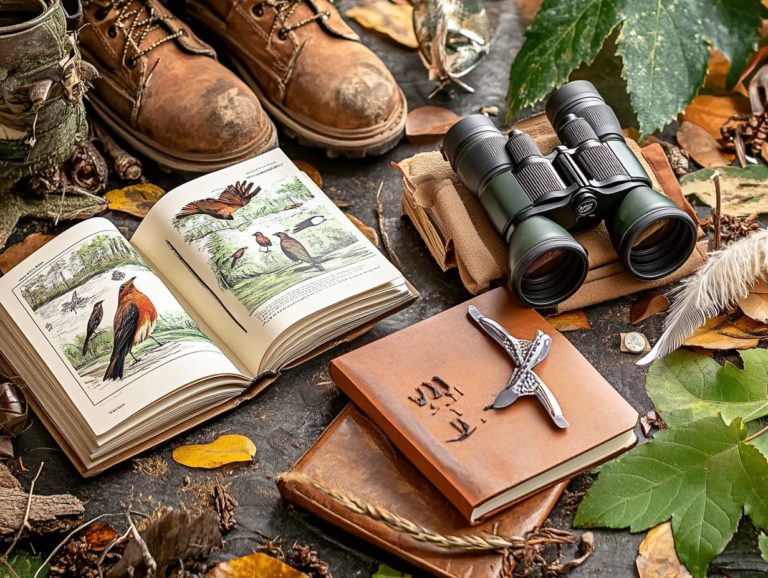How to Use Technology in Bird Watching?
In today s digital age, technology has revolutionized the way you experience bird watching, making it more accessible and enjoyable than ever before.
From advanced bird identification tools to streamlined data collection methods, tech gadgets have become indispensable allies for both novice and seasoned birders.
This article delves into the many benefits and types of technology employed in bird watching. It provides practical tips for seamless integration while also recognizing the challenges that may come your way.
Whether you re eager to upgrade your gear or sharpen your birding skills, there s something valuable here for everyone.
Contents
Key Takeaways:

- Technology enhances bird identification, data collection, and analysis, making bird watching more efficient and enjoyable.
- Binoculars, smartphone apps, and GPS tracking devices are commonly used in bird watching, providing various features and benefits for birders.
- When using technology in bird watching, it is important to follow best practices and etiquette and be aware of challenges such as environmental factors and technical difficulties.
What is Technology in Bird Watching?
Technology in bird watching brings an impressive array of smart devices and digital tools that elevate your birding experience. For instance, maximizing your birding experience with tech makes identifying different bird species and tracking your observations easy.
With innovative smart bird feeders like Bird Buddy and powerful birding apps such as eBird and Merlin at your disposal, you ll find that technology is transforming the way you engage with nature.
Imagine using binoculars equipped with cameras to capture breathtaking shots of Northern Cardinals and Blue Jays, all without disturbing their natural habitats.
These advancements also go beyond simple convenience; they create a more profound connection to the natural world. With birding apps, you have access to a treasure trove of information, including detailed bird calls, habitat descriptions, and migration patterns.
This wealth of knowledge helps you identify species more accurately and enriches your overall birding adventure.
Smart feeders also play their part by encouraging local wildlife and sharing feeding data. This can be invaluable for environmental monitoring and understanding local ecosystems.
You can effortlessly share your sightings and photographs in online communities, cultivating a sense of camaraderie among fellow bird lovers while championing conservation efforts on a global scale.
Benefits of Using Technology in Bird Watching
Utilizing technology in bird watching presents you with a wealth of advantages, from enhanced bird identification to streamlined data collection and real-time alerts, thanks to tech innovations in birdwatching apps that elevate your birding experience.
By harnessing smart devices and specialized applications, you can effortlessly track your interactions with wildlife. You can also contribute to projects where everyday people help collect data for scientific research and connect with a dynamic birding community.
The incorporation of features like live feeds and audio recordings not only deepens your understanding of various bird species but also plays a vital role in supporting conservation efforts.
Get started today and see how technology can enhance your birding adventures!
Enhanced Bird Identification
Enhanced bird identification through technology gives you the power to accurately recognize a diverse array of bird species using AI-powered apps and smartphone technology. This advancement makes birdwatching more accessible and engaging, whether you’re a novice or a seasoned birder.
Tools like Merlin and eBird are your real-time companions. They help you learn about bird calls and sightings while efficiently tracking your observations.
These exciting birding apps use smart algorithms to match the traits you observe with an extensive database of known birds. This simplifies the identification process effortlessly.
With user-friendly interfaces, you can navigate the features easily, uploading photos or recording audio clips for instant feedback on the species you encounter.
Many apps include geographic tracking, enhancing your experience by revealing local birding hotspots and trends. The integration of community features creates a space where everyone can learn together, allowing you to share your observations and tips.
As smartphone use is on the rise, these tools not only elevate your individual experiences but also contribute to broader citizen science initiatives. They help researchers gather invaluable data on bird populations.
Data Collection and Analysis
Data collection and analysis in bird watching have been transformed by technology, enabling you to compile extensive bird checklists and contribute valuable information to platforms like eBird. Additionally, utilizing the best bird watching apps can enhance your experience even further.
This not only supports citizen science and environmental monitoring but also aids you in tracking your birding journey while contributing to broader conservation efforts.
With these sophisticated tools at your fingertips, you can accurately identify bird species and log your observations in real-time. This fosters a vibrant community of engaged naturalists.
By harnessing data analytics, eBird reveals trends in bird populations and migration patterns. This information is essential for scientists and conservationists who monitor ecological changes.
Your participation in this collective effort provides critical insights into keeping the places where birds live safe and healthy, the impacts of climate change, and species at risk. This further solidifies the importance of citizen science in safeguarding avian diversity.
As a result, you not only enhance your personal birding experiences but also become an integral part of the ongoing dialogue about conservation strategies.
Types of Technology Used in Bird Watching

The world of bird watching technology presents an impressive array of devices designed to elevate your birding experience. By using apps to enhance your birdwatching skills, these innovations significantly improve your ability to identify and appreciate avian life.
- Smart bird feeders
- High-quality binoculars
- Smartphone apps
- GPS tracking devices
They also tackle common challenges that birders encounter, such as pesky squirrels and WiFi connectivity issues. For instance, tools like Bird Buddy come equipped with unique features such as solar charging and real-time bird alerts.
This makes it effortless for you to attract and observe a diverse range of feathered visitors.
Binoculars and Spotting Scopes
Binoculars and spotting scopes are essential tools for any bird watcher. They elevate your field observations and enrich your bird photography experience.
With modern features like powerful zoom lenses and image stabilization, you can capture breathtaking images of birds such as Northern Cardinals and Blue Jays from impressive distances.
These optical marvels offer different levels of zoom, allowing you to spot distant birds without intruding on their natural habitats.
Spotting scopes, known for their superior resolution and light-gathering capabilities, enable you to observe intricate details like feather patterns and behaviors, further enhancing your experience.
Look for features like waterproof construction and rubber armor, ensuring your gear remains durable in various weather conditions. This reliability makes them excellent companions for those long outings in the field.
The clarity and sharpness that quality optics offer elevate your bird photography, allowing you to seize those fleeting moments in nature and ultimately fostering a deeper appreciation for avian life.
Smartphone Apps
Smartphone apps dedicated to bird watching offer a treasure trove of features that make bird identification a breeze. These tools elevate your overall birding experience. Popular choices like eBird and Merlin equip you with tools to recognize bird calls, document sightings, and connect with fellow birding enthusiasts.
These applications often boast rich multimedia databases. You gain access to high-quality images and audio recordings that help differentiate between similar species. You can log your observations, contributing valuable data to conservation efforts and participating in projects where regular people help gather information. Many platforms encourage social interactions, allowing you to share your experiences, join local birding groups, or take part in challenges that inspire outdoor exploration.
This blend of technology and community engagement not only enhances your personal knowledge but also nurtures a collective passion for avian conservation.
GPS Tracking Devices
GPS tracking devices are invaluable for bird watching. They allow you to monitor bird movements and actively contribute to environmental monitoring and conservation efforts. These technologies provide profound insights into wildlife behavior and habitat usage, enhancing your understanding of local ecosystems.
The application of tracking devices goes beyond simple observation. They are vital tools for researchers investigating migration patterns, breeding habits, and habitat conservation. Conservationists analyze real-time data (information collected instantly) to pinpoint critical areas needing protection. They can adjust strategies to reduce human-wildlife conflicts. This not only elevates your birding experience but also galvanizes community efforts to protect endangered species.
Collaborative initiatives use the data collected, which plays a crucial role in shaping policies that promote sustainable environments. This ensures that future generations can savor the wonders of avian life, just as you do today.
Tips for Using Technology in Bird Watching
Utilizing technology in bird watching requires awareness of best practices and etiquette. Exploring the intersection of birding and technology ensures a respectful and enriching experience for both you and the wildlife.
Engaging with the birding community on platforms like Bird TikTok or other social media can amplify your experiences. You contribute to a culture that values conservation and respect for nature.
Best Practices and Etiquette

Adhering to best practices and etiquette is essential for you as a bird watcher. This ensures that technology enhances rather than disrupts your interactions with wildlife. Approaching birds quietly, respecting their habitats, and minimizing human interaction all contribute to a positive birding experience while helping maintain the delicate balance of nature.
Be mindful of your surroundings, especially avoiding sensitive areas during nesting seasons. Utilizing binoculars or spotting scopes allows you to observe from a distance, reducing stress on the birds.
Staying on designated trails is crucial for protecting fragile ecosystems. Emphasizing proper birding gear, like a field guide, will enhance your identification skills and deepen your appreciation while discouraging disruptive behavior.
Engaging in local conservation efforts can instill a sense of responsibility and stewardship within you. This fosters a deeper connection to the avian world and the environment as a whole.
Challenges and Limitations of Technology in Bird Watching
While technology offers numerous advantages for bird watching, it also introduces challenges and limitations. Understanding the impact of technology on bird field guides can help you navigate these issues to maximize your experience.
Environmental factors, such as unpredictable weather and habitat disruptions, can hinder the effectiveness of your smart devices. Technical difficulties, like WiFi connectivity issues, may disrupt your birding experience. Remember, even in a tech-savvy world, nature has its own set of rules.
Environmental Factors and Technical Difficulties
Environmental factors and technical challenges can greatly affect your bird watching experience.
Weather elements like rain or extreme temperatures impact the performance of smart bird feeders and cameras. Connectivity issues may disrupt GPS tracking devices and birding apps.
You may deal with problems like battery life draining quickly in cold weather or signals blocked by dense foliage.
Investing in weatherproof equipment and portable power sources can significantly enhance your setup during unpredictable conditions.
Familiarizing yourself with local conditions and timing your outings for the best times can elevate your experience.
Consider placement of your cameras and feeders to maximize accessibility. This ensures your technology operates reliably, enriching your bird watching adventure.
Frequently Asked Questions
What is bird watching technology?
Bird watching technology means using devices like cameras, binoculars, and apps to enhance your experience. It helps you identify and observe birds easily and accurately.
How can I use technology to identify birds?

There are many ways to identify birds using technology:
- Apps with bird call recognition features
- Binoculars with built-in digital cameras
- Electronic field guides
What kind of camera is best for bird watching?
A camera with high zoom capability and fast shutter speed is ideal. This allows you to capture clear images of birds, even from a distance.
Can I use my smartphone for bird watching?
Yes! Download bird identification apps to get information on species and their habitats. You can also take photos and record bird calls.
How can I use technology to track bird migrations?
Use bird tracking apps and websites that show real-time data from GPS-tagged birds. Radio or satellite tags can also help track specific species.
Is using technology in bird watching ethical?
Using technology is ethical as long as it doesn’t harm birds or their habitats. Always follow ethical bird watching practices and avoid disturbing birds.





